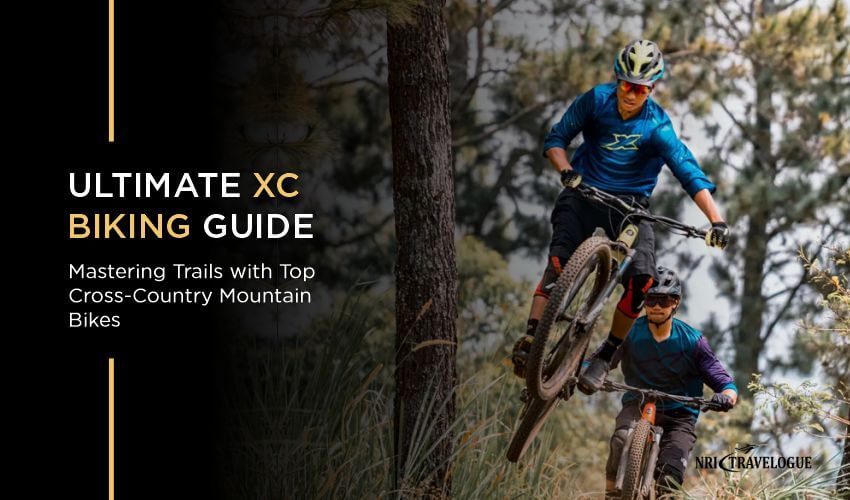Cross-country mountain biking stands out as the most widespread form of mountain biking, known for its combination of endurance, speed, and technical skills over varied terrains. This discipline of mountain biking emphasizes efficiency and agility during long rides through forest paths, mountain trails, and even competitive racing environments. Cross-country riders often face a mix of climbing, descending, and flat terrain, all requiring a bike that can handle efficiency in pedaling and maneuverability.
XC bikes are specifically designed to excel in these conditions. Compared to other types of mountain bikes, such as trail bikes or downhill bikes, XC mountain bikes are generally lighter and built with steeper angles to make climbing easier and to improve riding posture for long-distance efficiency. They typically feature shorter suspension travel than their more rugged counterparts, which helps keep the weight down and increases the bike’s responsiveness. The geometry of an XC bike is also tailored to offer the rider a balance of comfort and aggressive positioning, which is optimal for both speed and control during extensive rides.
These distinct characteristics make XC bikes highly suited for riders who enjoy long-distance adventures and those participating in competitive racing, where every second and pedal stroke counts towards the overall performance.
The Essentials of Cross-Country Bikes
Key Characteristics of XC Bikes
1. Lightweight Frames for Speed and Efficiency:
The hallmark of a cross-country mountain bike is its lightweight frame, which is essential for maximizing speed and efficiency, especially during climbs and long rides. Lighter bikes require less energy to maneuver and accelerate, making them ideal for competitive racing and extended cycling sessions.
2. Geometry Designed for Optimal Control and Quick Handling:
XC bikes are designed with specific geometries that promote better control and quick handling. This includes a steeper head angle for more responsive steering and a shorter wheelbase that contributes to nimble maneuverability. Such geometry helps riders navigate through tight trails and make quick adjustments in direction, which is crucial in cross-country scenarios.
Material Choices
1. Aluminum Frames:
- Pros: Aluminum is one of the most common materials used in XC bike frames due to its good balance of strength, stiffness, and lightness. It’s also relatively inexpensive, making it accessible for entry-level riders.
- Cons: While aluminum is lightweight and strong, it can be less forgiving on rougher trails, transmitting more vibrations to the rider than other materials.
2. Carbon Fiber Frames:
- Pros: Carbon fiber is lighter than aluminum and offers excellent stiffness, which translates to more of the rider’s energy being converted into forward motion. It also has natural vibration-damping properties, providing a smoother ride over bumpy surfaces.
- Cons: The main drawback of carbon fiber is its cost; it is typically found on more expensive bikes. Additionally, while it is strong, it can be susceptible to impact damage.
3. Titanium Frames:
- Pros: Titanium frames combine the best features of both aluminum and carbon fiber. They are incredibly lightweight, strong, and corrosion-resistant, with a natural flex that can absorb shocks better than aluminum.
- Cons: Titanium is often the most expensive frame material due to its manufacturing complexity and the cost of the raw material.
Performance Features of XC Mountain Bikes
Suspension Systems
The Role of Suspension in XC Biking—Hardtail vs. Full Suspension:
- Hardtail Bikes: Hardtail XC bikes have a suspension fork in the front but no rear suspension. This setup is lighter and typically less expensive, making hardtails more efficient on climbs and smoother terrains. The lack of rear suspension means there is less energy loss during pedaling, which is advantageous in race conditions or when speed and efficiency are paramount.
- Full Suspension Bikes: Full suspension models feature both front and rear suspension, which improves comfort and traction on more technical and rough terrains. Although slightly heavier and often more costly, full suspension bikes allow better control and less fatigue on longer, more challenging rides.
How Suspension Travel Affects Bike Performance and Rider Comfort:
- Suspension travel varies typically between 100mm to 120mm in XC bikes, which is less than what you would find in trail or downhill bikes. This shorter travel is designed to maintain a bike’s responsiveness and efficiency. More travel can absorb bigger shocks and smooth out rougher trails, enhancing rider comfort but potentially adding weight and reducing pedaling efficiency.
Drivetrain and Gearing
Importance of a Responsive and Reliable Drivetrain:
- A high-quality drivetrain is essential for XC biking due to the varying terrains and the need for quick, seamless shifting. Reliability and responsiveness in the drivetrain ensure that the bike can handle sudden changes in terrain and steep inclines without gear slipping or chain issues, which is crucial during competitive races or long-distance rides.
Common Gearing Setups for XC Bikes and How They Enhance Ride Performance:
- Most XC bikes are equipped with a 1x drivetrain system, meaning they have a single front chainring with a wide-ranging cassette at the rear. This setup reduces weight and complexity by eliminating the front derailleur. It offers a broad range of gears that make it easier to manage steep climbs and fast flats. The simplicity of a 1x system also reduces the chance of mechanical issues and improves aerodynamics.
Here’s a section that guides readers through the process of choosing the right cross-country (XC) mountain bike, focusing on fit and sizing, the importance of test riding, and budget considerations:
Choosing the Right XC Mountain Bike
1. Fit and Sizing
How to Choose the Right Size for Maximum Comfort and Performance: Choosing the correct size of an XC mountain bike is crucial for both comfort and performance. A bike that fits well will enhance your ability to handle the bike on diverse terrains and increase your endurance on long rides. To find the right size, consider your height and inseam measurements against the bike manufacturer’s sizing chart. However, keep in mind that each brand may vary slightly in their sizing, so these charts should be used as a general guideline.
The Importance of Test Riding Before Purchase: Test riding a bike before you commit to buying it is one of the best ways to ensure it fits well and meets your expectations in terms of handling and comfort. During a test ride, pay attention to how the bike feels in terms of reach to the handlebars, the comfort of the saddle, the ease of pedaling, and how well you can control the bike on turns and stops. This step is crucial and can significantly affect your satisfaction with the bike.
2. Budget Considerations
Entry-Level vs. High-End XC Bikes: What You Get for Your Money:
- Entry-Level Bikes: These bikes are typically built with more affordable materials like aluminum and might feature components that are durable but not optimized for competitive racing. They are suitable for beginners or casual riders who might not require top-of-the-line features but still want a bike that performs well on trails.
- High-End Bikes: High-end XC bikes often feature advanced materials such as carbon fiber, sophisticated suspension systems, and high-performance drivetrains. These bikes are lighter, stronger, and equipped with technology designed to enhance speed and efficiency, making them ideal for serious racers or those who want the best performance possible.
Tips for Finding Value in an XC Mountain Bike Purchase:
- Do Your Research: Understand the features that are most important for your style of riding and compare bikes across different brands.
- Consider the Long-Term: Investing a bit more in a higher-quality bike can save money in the long run as it might require fewer upgrades and less maintenance.
- Look for Last Year’s Models: Often, last year’s bike models are sold at a discount when new models are released, even though they still offer great technology and performance.
- Check for Deals and Sales: Keep an eye on local bike shops and online retailers for sales, especially during the off-season when demand is lower.
Maintenance Tips for XC Mountain Bikes
1. Routine Maintenance
Essential Regular Maintenance Tasks to Keep an XC Bike in Top Condition:
- Cleaning: Regularly clean your bike, especially after rides in muddy or dusty conditions. Use a gentle brush and a mild soap solution to avoid damaging the bike’s components.
- Lubrication: Keep the chain, derailleur, and other moving parts lubricated to ensure smooth operation and to prevent rust and wear.
- Tire Pressure: Regularly check and adjust tire pressure according to the riding terrain and weather conditions to ensure good traction and reduce the risk of punctures.
- Check Bolts and Screws: Ensure that all bolts and screws are tightened to the manufacturer’s specifications to prevent any parts from becoming loose during rides.
Seasonal Maintenance Tips to Extend the Life of the Bike:
- Before Wet Seasons: Apply water-resistant lubricants to protect metal parts from rust and corrosion. Consider using mudguards to protect your bike from excess mud and water.
- Before Dry Seasons: Focus on dust protection by ensuring all seals and bearings are clean and well lubricated to keep out dust and debris.
- Winter Storage: If storing your bike for the winter, clean and lubricate it thoroughly, inflate the tires to the correct pressure, and store it in a dry, cool place to avoid any damage or degradation.
2. Advanced Maintenance
When to Seek Professional Help for Bike Maintenance:
- Suspension Service: Professional servicing of the suspension system is recommended every year or after a specific number of ride hours, as detailed by the manufacturer, to ensure optimal performance and safety.
- Wheel Truing and Spoke Adjustment: If you notice any wobbling or unevenness in your wheels, it’s best to have a professional adjust and true them to avoid further damage or unsafe riding conditions.
- Comprehensive Tune-Ups: Consider a professional tune-up annually or bi-annually, depending on your riding frequency and conditions, to ensure all parts are in perfect working order.
DIY Tips for Common Issues Like Brake Adjustments and Chain Replacement:
- Brake Adjustments: Regularly check your brake pads for wear and ensure they are aligned correctly to the rim or disc. Adjust the tension in the brake cables if the braking response feels sluggish.
- Chain Replacement: Replace your chain every 1,000 to 2,000 miles, depending on usage. Use a chain checker tool to measure chain wear. A new chain helps maintain the efficiency of your drivetrain and prevents undue stress on other components.
Enhancing Your XC Riding Experience
1. Training Tips for XC Riders
Exercises and Training Regimens to Improve Endurance and Technical Skills:
- Endurance Training: Incorporate long, steady rides into your weekly routine to build cardiovascular endurance. Aim for consistent efforts at a moderate intensity to help your body adapt to long durations in the saddle.
- Interval Training: Boost your cycling power with interval training. Include sessions where you alternate between high-intensity bursts and recovery periods to improve your speed and recovery times.
- Strength Training: Focus on core strength, as well as leg and arm muscles. Exercises like squats, planks, and deadlifts can enhance your biking performance by improving stability and power.
- Technical Skills: Practice on various terrains to enhance your bike handling skills. Drills like tight turns, steep descents, and obstacle navigation are crucial for improving confidence and efficiency on challenging trails.
Nutrition and Hydration Strategies for Long Rides:
- Before the Ride: Eat a balanced meal with carbohydrates, protein, and healthy fats to fuel your body for the endurance it will need.
- During the Ride: Stay hydrated and replenish your energy with snacks high in carbs and electrolytes. Energy bars, gels, and bananas are popular choices. Drink water regularly, even before you feel thirsty, to prevent dehydration.
- After the Ride: Recovery is crucial, so consume a mix of carbs and protein shortly after your ride to aid muscle recovery and replenish glycogen stores.
2. Upgrading Your Bike
Recommended Upgrades to Boost Performance and Comfort:
- Tires: Upgrading to lighter, more durable tires can significantly improve your ride’s efficiency and traction on diverse terrains.
- Suspension: Consider upgrading your suspension system for better shock absorption, especially if you frequently ride on rough trails.
- Saddle: Investing in a high-quality saddle can increase comfort dramatically, particularly on long rides.
- Handlebars and Grips: Upgrading to ergonomic handlebars and grips can enhance control and reduce fatigue on your hands and upper body.
How to Prioritize Upgrades Based on Your Riding Style and Needs:
- Assess Your Riding Style: Determine whether you prioritize speed, comfort, or versatility. For example, if you often ride on rugged trails, focus on upgrading your suspension and tires first.
- Consider Your Weak Points: If you notice particular aspects of your bike are slowing you down or causing discomfort, prioritize these for upgrades. For instance, if you suffer from soreness during long rides, look at saddles and pedal systems first.
- Budget Constraints: Always consider your budget. Start with the upgrades that will offer the most significant improvement in performance for your money, and plan others as your finances allow.
Wrapping Up
Choosing the right XC mountain bike and maintaining it properly are crucial steps toward enjoying and excelling in the sport of cross-country mountain biking. Throughout this guide, we’ve explored essential aspects of XC bikes, including their lightweight frames, specific geometries for speed and control, and the differences in suspension that cater to various riding styles and terrains. We also discussed how to select the right bike based on fit, budget, and personal needs, emphasizing the importance of a test ride before making a purchase.
Maintaining your XC bike is equally important to ensure it performs at its best and lasts longer. Regular maintenance tasks like cleaning, lubricating, and checking tire pressure, along with seasonal checks and professional services, keep your bike in optimal condition. Furthermore, enhancing your riding experience through targeted training, proper nutrition, and strategic upgrades can significantly improve your performance and enjoyment of the sport.
Cross-country mountain biking offers a unique blend of physical challenge, mental relaxation, and the opportunity to connect with nature. Whether you’re a competitive racer or a recreational rider, XC mountain biking can be incredibly rewarding. We encourage you to explore the trails, push your limits, and enjoy every moment of adventure that XC mountain biking brings.
Remember, every ride is an opportunity to improve your skills, fitness, and appreciation for the great outdoors. So gear up, get out there, and experience the thrill and joy of XC mountain biking.









